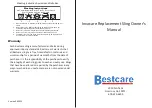
5
ES
IT
FR
NL
DE FI
DA NO
SV
GB
ILL.
Practical handling
Sling can best be described as an extra arm or arms for the
carer. Sling can be positioned where it has the greatest effect.
Positioning
Use
Moving the user higher up in the bed:
Position Sling under the user’s pelvis so that the non-slip
surface is facing the user and the nylon back is against the
underlying surface. The carers stand at either side of the bed,
one foot forward and pull the user slowly higher up using weight
transference (Illustration 1).
To reduce friction on the shoulder blades, we recommend using
MultiGlide or MultiGlide Glove.
To glide back in the chair:
Position Sling under the user’s thighs so that the non-slip
surface is facing the user and the nylon back faces the seat.
If the wheelchair is low – the carer stands behind the chair –
grasp Sling’s handles with arms outstretched and prompt a
“thigh-walk” movement by gently rolling and pulling the user
backwards.
If the wheelchair is high – two carers stand at either side of the
wheelchair – Sling is then crossed behind the user’s back – this
again prompts a “thigh-walk” movement – the carers take turns
to roll and pull the user backwards.
In cases where the user has poor balance when leaning forward,
we recommend an extra carer.
Manual handling between two surfaces (seated):
Sling can also be used for manual handling in a low seated
position. Sling is positioned under the user’s pelvis. The carer
grasps Sling close to the body and the user is raised to the
standing position using weight transference.
Alternatively, the carer can pull the user up from e.g.
a bed to a wheelchair, using a glide board (if necessary)
(Illustrations 2 and 3).
Legs in/out of bed:
Position Sling around the user’s ankles. The carer can now lift
the user’s legs up into the bed. Alternatively, the functional
handles can be hung onto the hoist. When the lift is raised, the
legs are lifted with it and can then easily be pushed into position
on the bed.
























